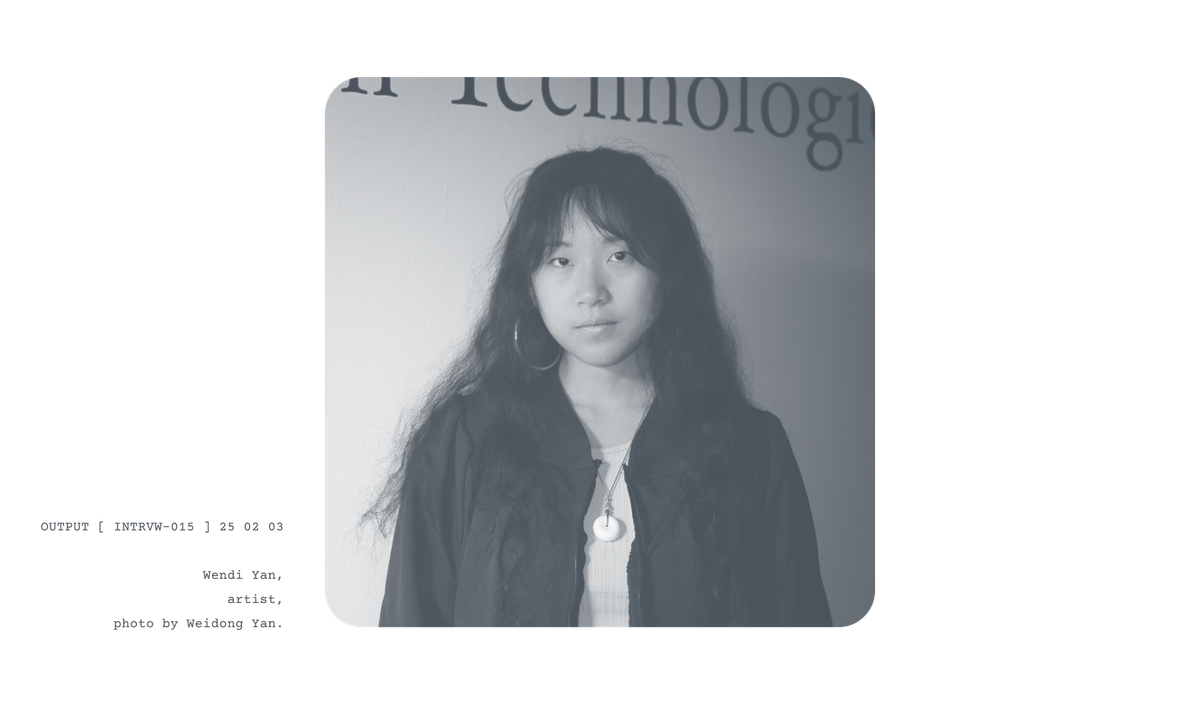Wendi Yan, Artist

Wendi Yan is an artist building research-based worlds about alternative sciences through game engine, film and sculptures.
APOSSIBLE™ is a non-profit bringing psychologists, technologists, artists and creatives together to explore how technology can better support creativity and human fulfillment. In this ongoing interview series we’re discovering what people value, what makes their lives fulfilling, and what kinds of relationships to technology they already cherish.
1. What is a ritual, practice, or routine in your life that is important for your psychological wellbeing and/or fulfillment? Why?
Starting my day with walking. I love walking, either in the gym or outside, before I start doing serious work in the morning. There is a curious part of our embodiment, where moving our body literally helps our mind get going. I really feel it. Sometimes the moment I start walking outside, my mind immediately gets more unclogged, and I gain new thoughts, perspectives and mental imageries for questions I was stuck on the previous day.
When my body is in motion, perhaps my subconscious feels more agency, and my mind becomes more active in seeking answers. Similarly, when I feel down, I like to dance to music by myself, without judgment for how I move, and listen to the music with my body. It helps elevate my mood. I am a firm believer that mind and body are connected in complex ways we don’t fully understand yet, and there are somatic solutions to (what appears to be) psychological or mental problems.
Walking outside also makes me viscerally feel that I am “in the world.” I am an active participant of the world. And there are a lot of things I can do to become a better participant.
2. What is a human-made creation that brings out the best in you? Why?
3D software, specifically Blender and Unreal Engine, are tools I use to make my own worlds. They have become an intimate extension of myself. Miguel Sicart said that world-building is re-ontologizing. That’s how I see it too. When I design, model, and animate my imagined scientific instruments, when I make a game that embodies a different cosmology, I am practicing a kind of mental liberation from the mainstream paradigm of technology and view of nature.
3D software allows me to make a home-brew sci-fi that emancipates me from the dominant scientific imagination, and I find that absolutely empowering. With a short animation, or a game, I can invite others to temporarily inhabit another logic of the world, another geometry of history, another method of knowing, another way of viewing life, and even another law of physics (like pataphysics, I suppose).
3. When do you cherish the slow or hard way of doing something? Why?
There is an invisible part of my work that requires extensive labor in reading scholarly work, consulting people of different professions, and then really sitting with a ton of ideas to synthesize a new one. World-building to me is much more than the visual design of a world, or even its laws in the present tense: I think about its past, core philosophy, and the culture out of which all the objects and characters arise. Imagining a world with a different history, cosmology or even laws of physics is very hard. It probably takes years to make a good one.
But I prefer to go through this hard route of world-building, because it demands me to ask and think deeply: in what ways did the Greek and Chinese technological traditions embody inherently different ontologies? Who were the individual actors that brought scientific knowledge from the West to the East, and specifically how did they do that? What were the knowledge economies they dealt with, and how did they collide? If we fork a different branch of history from three centuries ago, what technologies could the world be using now? It sounds cheesy, but the process matters, or is a product in itself.
Through making an imaginary world, the world transforms me. It makes me see the materials and shapes of technology around me in this world with a renewed perspective. World-building is a research project, except the outcome is a fictional world, instead of a scholarly essay, because I see world-building as narrative engineering. We need more ontological plurality in the myths that guide us.
4. What is something you appreciate or long for from the past? Why?
The syncretist view of art and science. The Western world used to treat them as the same kind of practice. The divided perspective and the professionalization of science and art only came about in the last two centuries. I understand there was a historical need for it, but I always wonder if we can bring that syncretist outlook back, in a framework legible to our times.
On an individual level, I often see people struggling with reducing themselves into one specialized field within one discipline. At large, scientists and artists are so sociologically detached from each other now, despite the shared creative nature in their work. I’m compelled to wonder how existing ideas can be transmuted, and how new ideas may be synthesized, if aesthetic and epistemic practices came closer together in today’s world.
